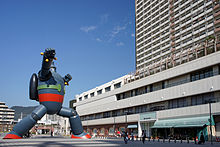- Mitsuteru Yokoyama
-
Mitsuteru Yokoyama Born June 18, 1934
Kobe, JapanDied April 15, 2004 (aged 69)
Tokyo, JapanNationality Japanese Occupation Manga artist Known for Tetsujin 28-go[1]
Giant Robo'Mitsuteru Yokoyama (横山 光輝 Yokoyama Mitsuteru, June 18, 1934 - April 15, 2004) was a Japanese manga artist born in Suma-ku, Kobe-shi, Hyogo. His personal name was originally spelled Mitsuteru (光照), with the same pronunciation. His works include Tetsujin 28-go, Giant Robo, Akakage, Babel II, Sally, the Witch, Princess Comet, and adaptations of the Chinese classics Outlaws of the Marsh and Romance of the Three Kingdoms.
Contents
Biography
Early life
Yokoyama spent his boyhood during World War II and was evacuated to Tottori with his family. He graduated from Kobe municipal Ota junior high school and went on to the Kobe municipal Suma high school. Osamu Tezuka's "Metropolis" made a deep impression on Yokoyama who wished to become a manga artist in earnest and so he contributed his works to a comic book in his high school days. He entered the Sumitomo Mitsui Banking Corporation after graduation from high school, but quit his job before five months passed because there was no time to draw a manga. He found a new job as a publicity department member for a movie company based in Kobe and pursued his manga artist career on his free time.
Professional career
Yokoyama came out with the book "Otonashi no Ken (音無しの剣 Sword without sound)" for his manga artist début, which caught Osamu Tezuka's attention.
In 1955, Yokoyama had a title serialized in the magazine Shōjo for the first time, "Shirayuri Koushinkyoku (白ゆり行進曲 White Lily March)".
In 1956, "Tetsujin 28-go" appeared serially in the magazine Shōnen after he resigned from the movie company. "Tetsujin 28-go" became a popular work equal to Tezuka's "AstroBoy and its animated adaptation also made a smashing success. This prompted Yokoyama to become a full-time manga artist and to move to Tokyo the same year.
In 1964, he established Hikari Production, an incorporated company. Making good use of his vast exposure to movies during his previous job, he produced consecutive popular hits in various genres, both in comics and anime, such as "Iga no Kagemaru (伊賀の影丸 Kagemaru of Iga)", "Akakage", "Sally the Witch", "Giant Robo", "Babel II" and so on. With the writing of "Suikoden (水滸伝 Water Margin)" (1967–1971) and "Yokoyama Mitsuteru Sangokushi (Records of Three Kingdoms)" (1971–1986), he began a new chapter in his career as he drew mostly comics based on original stories with material from China's and Japan's History.
In 1991, "Yokoyama Mitsuteru Sangokushi" won the prize for excellence from the Japan Cartoonist Association [2] and an animated version was broadcast on TV Tokyo.
In July 1997, Yokoyama was hospitalized with myocardial infarction and had an operation. He returned to work in next year March.
In 2004, while under medical treatment, Yokoyama won the MEXT Prize of the Japan Cartoonist Association.
On the morning of April 15, 2004, Yokoyama suffered burns all over his body due to a fire breaking out in his house. His condition deteriorated and he fell in a coma. Yokoyama died in the hospital near his home at 22:00 on the same day, aged 69.[3]
Style
The attractions of Yokoyama's works are calculated story deployment and an elaborate setting. On the other hand, Yokoyama liked light characterizations and doesn't let characters show their feelings too much. He was better at a serious story manga rather than with comedy, but he drew some also.
Yokoyama is one of the originators of present day Japanese comics. While Tezuka established the technique to draw Japanese comics, it was Yokoyama who established the format of various genres of current Japanese comics and anime. Whereas many comic artists prefer their original stories not to be changed when adapted, Yokoyama was realistic and tolerant, so many of his works were made into animation or Tokusatsu.
- "Tetsujin 28-go" & "Giant Robo" are ancestors of the genres called Super Robot.
- "Iga no Kagemaru (伊賀の影丸 Kagemaru of Iga)" & "Akakage" are ninja manga which created a ninja boom. These comics present stories in which ninja are endowed with superhuman fighting capabilities.
- "Yami no Doki (闇の土鬼 Doki (soil ogre) of the darkness) " is a Jidaigeki in which real world persons appear.
- "Sally the Witch", the first magical girl manga/anime & "Princess Comet" are shōjo manga.
- "Yokoyama Mitsuteru Sangokushi" is a historical story based on historical facts and historical novels.
- "Babel II" is a supernatural power science fiction comics.
Influence on the manga world
Hirohiko Araki
Hirohiko Araki said that he was conscious of Yokoyama's hard-boiled style in that he sticks to suspense and describes the hero's character drily.[4]
Katsuhiro Otomo
A few characters of Katsuhiro Otomo’s "AKIRA" are named after characters from "Tetsujin 28-go."
- "Shotaro Kaneda" is Shotaro Kaneda.
- "Tetsuo Shima" is Tetsuo, the son of Dr. Shikishima who made Tetsujin.
- "Colonel Shikishima" is Dr. Shikishima.
- "No.28" of Akira is 28-go of Tetsujin.
Naoki Urasawa
Some names of characters in Naoki Urasawa's "20th Century Boys" are references to "Tetsujin 28-go."
- "Professor Shikishima" is Dr. Shikishima.
- "Shotaro Kaneda", a student of the Shikishima seminar, is Shotaro Kaneda.
- "Professor Tetsuo Shikishima" of the movie version is Tetsuo Shikishima.
References
- ^ "Fire kills Japanese manga artist". BBC. http://news.bbc.co.uk/1/hi/entertainment/3631529.stm. Retrieved 2011-10-23.
- ^ "List of recipients of the Japanese Cartoonist Association Awards" (in Japanese). Archived from the original on 2007-02-19. http://web.archive.org/web/20070219190000/http://www.nihonmangakakyokai.or.jp/jushou.html. Retrieved 2007-02-28.
- ^ News from Yomiuri Online (Japanese)
- ^ Manga Meister vol.3 (Japanese)
External links
- Mitsuteru Yokoyama Official Website (Japanese)
- Mitsuteru Yokoyama at Anime News Network's Encyclopedia
- Mitsuteru Yokoyama at the Internet Movie Database
Tetsujin 28-go by Mitsuteru Yokoyama Tetsujin 28-go (film) • Gigantor • The New Adventures of Gigantor • Tetsujin 28 fx • 2004 TV Series • Tetsujin 28-go: Hakuchū no ZangetsuCategories:- 1934 births
- 2004 deaths
- Manga artists
- People from Kobe
- Deaths from fire
Wikimedia Foundation. 2010.

